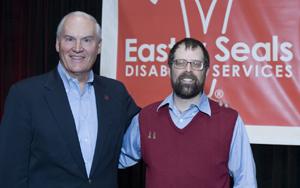Inclusion, or segregation?
by Patricia Wright
A Wall Street Journal article reports on parents choosing to enroll their children with autism in segregated programs at school instead of including them in classes with their peers.
Last fall, groups who favor placing disabled students in regular classrooms faced opposition from an unlikely quarter: parents like Norette Travis, whose daughter Valerie has autism.
Valerie had already tried the mainstreaming approach that the disability advocacy groups were supporting. After attending a preschool program for special-needs students, she was assigned to a regular kindergarten class …
“She did not learn anything that year,” Ms. Travis recalls. “She regressed.”
Segregation is a hot topic in our society — class action lawsuits have made it to the Supreme Court. The issue of segregation and students with disabilities has many sides.
Quotes from parents like Ms. Travis make me think the debate isn’t so much about placement, but about outcomes. Parents — and I mean parents of kids with disabilities and parents of kids who are typically developing — send their children to school to learn.
When learning doesn’t occur, parents start to look elsewhere. Restrictive placements — often featuring a lot of instructional support — begin to look more attractive.
As a high school teacher, I have seen the benefits of students with disabilities participating in classrooms with their peers. Here’s how it worked:
- For part of the day, students with disabilities attended classes with 28 or so general education students. All of the students received systematic instruction. Students with disabilities had proper supports when necessary.
- Para-educators provided support while students with disabilities developed vocational skills working in the school office.
- For one period a day, students with disabilities rode public transportation into the local area for community-based instruction.
All of these activities had measurable outcomes — the students were learning.
So I agree with Ms. Travis … if a child is regressing, it’s time for change. But perhaps the change is not to a segregated placement, but to an integrated environment with the proper support for learning.







 I had the pleasure of meeting Shore at our 2007 Easter Seals Training Conference in April. Shore is a well-known public speaker, and at the conference he provided a personal perspective on the experience of living with autism. His presentation was truly one of the highlights of the conference. There were over 400 people in attendance that day and they walked away with a much better understanding of autism.
I had the pleasure of meeting Shore at our 2007 Easter Seals Training Conference in April. Shore is a well-known public speaker, and at the conference he provided a personal perspective on the experience of living with autism. His presentation was truly one of the highlights of the conference. There were over 400 people in attendance that day and they walked away with a much better understanding of autism. This time of year, I find myself reflecting on what I am most thankful for. I have so many things in my life that have truly blessed me, but one of the most amazing blessings is having an autistic son.
This time of year, I find myself reflecting on what I am most thankful for. I have so many things in my life that have truly blessed me, but one of the most amazing blessings is having an autistic son.